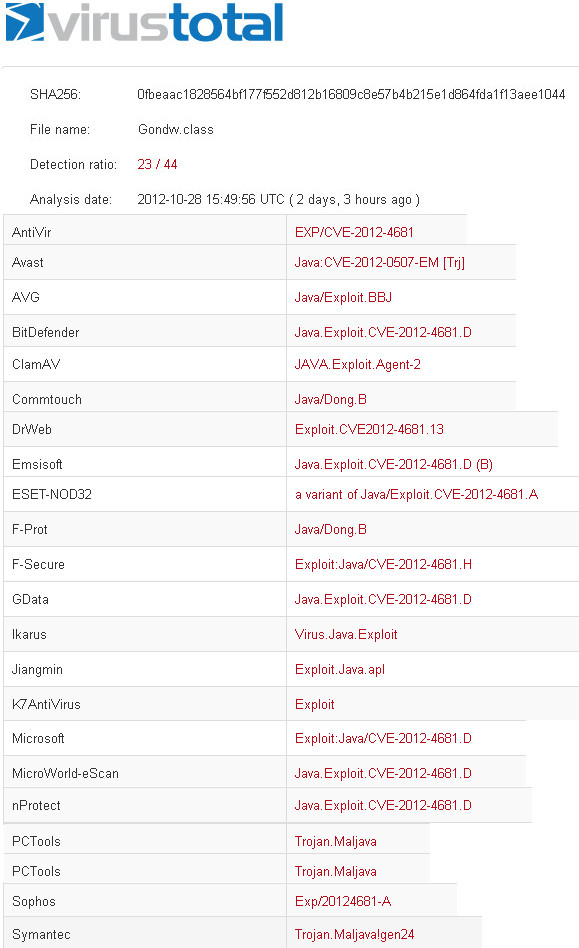Styxy Cool Exploit Kit: One Applet to Exploit All Vulnerabilities
Styxy Cool Exploit Kit is a particular kit because it is a "merge" between Cool and Styxy Exploit Kit. Here we are going to cover only Java related exploits so, if you want to know what vulnerabilities it has and why its called Styxy Cool go check Kafeine's post here.
Between the eight and nine of July two interesting things happened:
- Jar size increased from 5Kb to 28 Kb
- Payload (Reveton) disappeared from fiddler
Let's take a step back and analyze the exploit chain from the eight of July.
The first page /abortion-success_conductor.php displays a bounch of phrases about Yahoo France, but what really does is checking if you have some vulnerable Java plugin installed in your browser.
The page contains an instance of PluginDetect version 0.8 plus an obfuscated JavaScript code.
The page contains an instance of PluginDetect version 0.8 plus an obfuscated JavaScript code.
What does this code do ?
It takes the content of the textarea from /objection_confident_sulphur.html since in the middle of the first page there is an iframe pointing to that one.
Then converts two chars per time into an integer base 30 and converts the result into a character with the help of String.fromCharCode.
Once deobfuscated.
If you are vulnerable the next and last page executes the malicious applet. In this case i was using Java SE 7 update 17 so /test_membrane.html contains CVE-2013-2423.
Jar size
If we open the malicious jar with JD-GUI we can see an if/else statement inside the Main.class where it tries several exploits.
Missing Reveton
As you can see Reveton is never downloaded but you still get infected.
Therefore, how the payload is downloaded ?
My first thought was that it was embedded into the jar, but after a deep search i haven't found any trace. Looking better after the infection, i've noticed an uncommon V.class file inside the Temp folder.
Part of disassembled V file.
Mistery solved, this java compiled class is responsible of downloading and executing Reveton.
How this class is executed ?
At the beginning of the init function useInner variable takes the value of usein applet parameter, but since there isn't any parameter called usein, its value will be null.
The following line calls dgsdgDG from MainAdd2.
Once again there isn't any parameter called val, so getUrls it's executed.
My first thought was that it was embedded into the jar, but after a deep search i haven't found any trace. Looking better after the infection, i've noticed an uncommon V.class file inside the Temp folder.
Part of disassembled V file.
Mistery solved, this java compiled class is responsible of downloading and executing Reveton.
How this class is executed ?
At the beginning of the init function useInner variable takes the value of usein applet parameter, but since there isn't any parameter called usein, its value will be null.
The following line calls dgsdgDG from MainAdd2.
Once again there isn't any parameter called val, so getUrls it's executed.
After obtained the URL of the applet and substituted the extension jar with exe?e=15, a last function called run is executed. Its purpose is to write V.class into Temp folder and call it through the command "javaw -cp <path_tmp_folder> V <reveton_url>".
There isn't a lot of code to deobfuscate, but you can find whole V.class here. Jar file is available on Kernelmode previous registration: http://www.kernelmode.info/forum/viewtopic.php?f=16&t=1819&start=60#p20209
Maybe a better title for this post is: One exploit to rule them all, one exploit to exploit them, one exploit to infect them all and in a botnet bind them.
# Edit 1
Balck Dragon and Blackhole 2.1 have the same behaviour.
Related post:





















One Ring to rule them All, Eh ???
ReplyDeleteOne Ring to find them, One Ring to bring them all, And in the darkness bind them :)
Deletehow i can get this kit
ReplyDelete